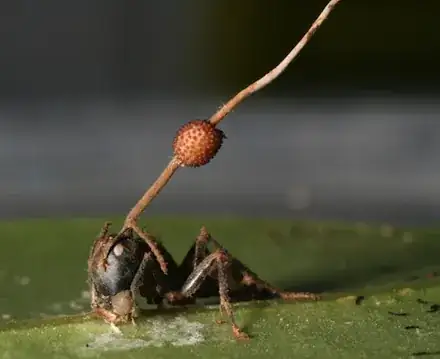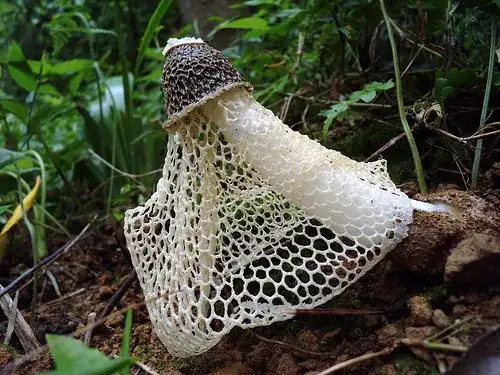Edit: I did the math and turns out I may've misjudged the sun: it gives more energy than I thought. See edit at bottom.
This has partly been answered here:
Sentient trees. Can they develop technology?
But this question is more of a precursor to that: can such trees ever come about in the first place?
I think this requires a definition of "plant" vs "animal".
Here on earth, this is nice and clear. Stuff in the kingdom "Plantae" is plants. Stuff in the kingdom "Animalia" is animals.
Panspermia aside, alien stuff can't be descended from either our plants, or our animals, or any of our other biological kingdoms.
So what, in an alien world, is a "plant"?
In the question I linked above, it meant "has roots" and "gets all its energy from sunlight, rather than from digesting stuff".
I'm assuming you don't have the constraint that it must have roots, nor even that its nutrients must come from the earth, since the question describes the "plants" moving around.
So that means photosynthesis or something similar.
There are two constraints there: how bright and constant the sun is; and how efficiently the light is converted into usable energy.
Those two multiplied together gives the energy that the plant has to work with. That in turn governs how much physical activity and data processing the plant can perform.
We know that solar energy can power simple computers, and trees, and have energy left over to make tasty fruit, so we can argue it could power a simple nervous system, albeit slow-moving.
So it's feasible that they could form, if there were no faster-moving predators: if they weren't at the bottom of a food chain.
So the main question we need to ask is... why don't faster-moving, shorter-generation critters form and become technological first?
And I think the answer there could be that the light is near-constant (binary star? Big reflective moons? something).
So there's no point storing energy as sugars and valuable resources. You get some energy, you convert it into value as soon as possible. Parasites evolve for those that do store it, but they'd be small and few as most avoid the problem of parasites by just using their resources.
At that point, the only parasites would be parasites of nutrients, not of energy. So plants would prey on each other for nutrients, but at a solar-energy-driven pace.
Some parasites might tap into the energy flow between "leaves" (whatever solar energy collecting part of a plant) and wherever the energy gets used, but to gain any advantage, these would have to be parasites (harvesting long-term from a living creature), rather than predators (harvesting and digesting). So you might end up with cases of symbiotic parasitism, and cases of escalating arms races against the parasites.
TL;DR: If energy is not stored in these alien plants, but rapidly converted from source to use, and the sun is bright and conversion is efficient, then preying on vegetation is not worth the cost, so animals might not form. In such a case, plants might have time to develop a slower-moving technological society without getting beaten to it by faster-moving animals.
Edit: I am unhappy with my own answer. It's too vague.
Let's get to HARD NUMBERS!
Let's make the assumption that you can't make the sun much hotter or the planet will fall out of the "goldilocks" zone, there'll be no liquid water, and so on. That means it's all down to efficiency of energy conversion.
A human uses about a megajoule per day. One watt is one joule per second. There are 86400 seconds in a day. Humans, depending on age, gender and activity, use from 6.5MJ (sedentary 50 yearold female) to 13MJ (active 17 yearold male) per day. A joule is a watt per second, so we can divide those by the number of seconds in a day (86,400) to get the average power usage of a human: 75-150W. About one lightbulb.
This is in theory the energy AFTER our gross inefficiencies have been factored out, though: that's metabolizable energy, per the Atwater System. Of the metabolized efficiency, however, we still have inefficiencies: about 25% according to https://openoregon.pressbooks.pub/bodyphysics/chapter/human-metabolism/.
From https://en.wikipedia.org/wiki/Sunlight, the sun delivers 1367 Watts per square metre to the planet, of which 1050 reaches the ground for the part of the earth directly facing the sun. It also cites the "Average over the entire earth" of "164 Watts per square meter over a 24 hour day".
To doublecheck that number, https://en.wikipedia.org/wiki/Solar_cell_efficiency cites as a low bound "Michigan, which receives only 3.8 kWh/m2/day" - this works out to 158 Watts.
So it seems on its face as if it's possible, if solar can be converted with as high efficiency as the human body's 25%.
https://en.wikipedia.org/wiki/Photosynthetic_efficiency says:
For actual sunlight, where only 45% of the light is in the
photosynthetically active wavelength range, the theoretical maximum
efficiency of solar energy conversion is approximately 11%. In
actuality, however, plants do not absorb all incoming sunlight (due to
reflection, respiration requirements of photosynthesis and the need
for optimal solar radiation levels) and do not convert all harvested
energy into biomass, which results in a maximum overall photosynthetic
efficiency of 3 to 6% of total solar radiation.
Elsewhere it cites lower percentages, as low as 0.1%, or one one-thousandth of incident light. That's not good!
https://en.wikipedia.org/wiki/Solar_cell_efficiency says:
As of December 2014, the world record for solar cell efficiency at 46.0% was [...] above the standard rating of 37.0% [...] The maximum theoretical efficiency calculated is 86.8% for a stack of an infinite number of cells, using the incoming concentrated sunlight radiation. When the incoming radiation comes only from an area of the sky the size of the sun, the efficiency limit drops to 68.7%.
So, using more efficient systems than Earthly photosynthesis, we can get some OK efficiency. A humanlike 25% is achievable, and perhaps 30-40% is reasonable.
Let's assume they can shut down completely for the night, or they're in the L1 spot between two suns so get constant light or something. Skipping night, that doubles the average power of their waking hours immediately, to ~316W. We need to be able to use 75W after efficiency losses for little-old-lady levels of energy use, so we'd just scrape in at 25% efficiency.
If you double the surface area, giving 2 square metres, then again you'd double the gained energy. 2 square metres isn't that much: a radius of just 80cm or 32 inches: equivalent to a human wearing a golfing umbrella (or ballgown, depends on the shape of your beings) the size of their outstretched arms.
Combine both a sedentary nighttime phase, and a 2-square-metre area, and you only need 12% efficiency to have human levels of activity.
If you quarter their metabolism compared to ours, then you get 3% efficiency: that's within reach of even Earth's photosynthesis.
An full-grown oak tree has 40ft diameter, giving well over 100 square metres. Requiring just 0.06% efficiency (well, a little more, because they have bigger bodies), Tolkien's slow-moving ents seem like they might be feasible!
So, TL;DR: I was wrong, it's certainly within the bounds of physics and math for a luxophagic plant to exist with humanlike levels of metabolism. And if, as in the OP, they couple it with eating other plants for their energy, there's absolutely no problem even with dancing and running trees... but then at that point I'm not sure what the definition of a "plant" is.



